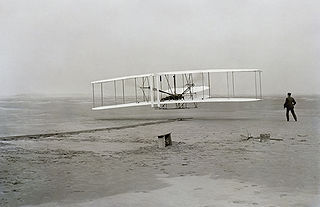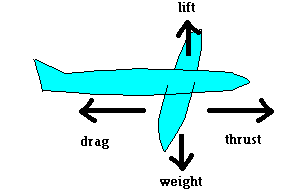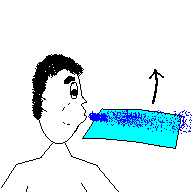
Key Terms
Bernoulli's Principle (Venturi Effect)
drag
empirical approach to learning
momentum (conservation of)
lift
thrust
weight

Otto Lilienthal in action Courtesy Wikimedia Commons

Orville Wright makes history Courtesy Wikimedia Commons
The four main forces an airplane has to deal with are:

In principle, the math is quite simple:
Let's start with the "classic" approach to understanding lift. Airplane wings are designed with an airfoil shape. This shape, in theory, means the air travels faster over the upper portion of the wing than it does at the bottom of the wing.
Lift is achieved by understanding Bernoulli's Principle. Bernoulli discovered that the pressure exerted by a fluid (liquid or gas) decreases as the speed of the fluid increases. That is, as air moves faster over the top portion of the wing, the pressure exerted by the air decreases! This provides lift. We can demonstrate several examples of Bernoulli in action. The simplest is to take an ordinary sheet of paper and blow over the top of it. You should notice it lift up. Try reversing the direction of air flow in a shop-vac (so it blows out) ... and hold it straight up. You can suspend light objects in the "low pressure" column of air where they appear to dance in mid-air.

(animation)
As you can easily demonstrate, the pressure exerted by a gas or liquid actually does depend on the speed of the fluid. This observation was noticed by Daniel Bernoulli (1700-1782) and his work was completed by Leonhard Euler (1707-1783) in the form of an equation.
Bernoulli found that as a fluid moves with a steady-state flow through a pipe, if the speed of the fluid increases, the pressure of the fluid drops. If the speed falls, the pressure increases. In fact:

Bernoulli's Equation deals with simple steady-state flow of a non viscous fluid. That is, the fluid is moving without sudden and chaotic motion, ... but only with gradual changes in its state of motion. The fluid must also show no sign of internal friction as it flows (cold honey would not work here, ... but if you heat it up, it may be considered). For example, water moving through the pipes of your house is a very good example of this "near ideal" situation. We need to get past the equation and understand why this works. Consider water flowing through a pipe which gradually gets narrower.

Slower motion (acceleration zone)
Faster motion
(animation)
As water moves in a pipe which changes from a larger diameter to a pipe with a smaller diameter, the speed of the fluid must increase. This should come as no surprise because the same volume of water must pass by a given point each second. What also occurs is the pressure exerted by the fluid changes! It drops from high pressure to lower pressure. To see why this happens, consider what is happening to the water as it enters the narrowing. It is accelerating! From Newton's 2nd law, we learned that an object will accelerate only when there is a net force applied to it. In this case, the water will only accelerate when there is a pressure difference acting on it. That is, if there was no pressure difference in the water, the water would not accelerate at the narrowing.
If we go back to the airfoil, the faster moving air over the top of the wing lowers the pressure and gives lift. However, this thought falls short of theory because this equation assumes that the fluid is not compressible (and air is quite easily compressed) and also ignores the effects of turbulence (small eddies and back currents) that affect the final analysis. In addition, there is an underlying assumption that two air molecules split at the front of the airfoil (one going over, the other going under the wing) will meet again at the tail of the wind. This is NOT the case in reality. The fact is, there is considerable controversy regarding how much lift is produced by the Bernoulli Principle. If this was the ONLY explanation for lift, airplanes could not possibly fly upside down!
Some experts suggest (link 5.3.b or link 5.3.c) that lift experienced by the airfoil is mostly due to Isaac Newton (and much less due to Bernoulli).
An alternative idea to create lift involves Newton's Third Law which states, "For every action (force) there is an equal and opposite reaction (force)". The Action - Reaction in this case occurs between collisions of air molecules with the wing. According to this explanation, air that hits the bottom of the airfoil is directed downward. As a result of this collision, the wing is forced up. This should make perfect sense. Also, the air moving over the top of the wing creates lift because the air ends up with a net downward motion after it leaves the wing. This is because fluids moving in close contact with a surface show an attraction towards the surface. This is known as the Coanda effect. As a result, the wing must achieve a net upward lift since all forces must be equal and opposite (if air is pulled down, the wing must be forced up)!!! So are you ready to throw out your old physics book? The whole point is ... a complete explanation as to why an airplane is able to provide lift is still unclear. Does this seem odd to you? We routinely fly airplanes, but still don't understand the science of aerodynamics. This is a true testament to the empirical approach to learning.
The theory of aerodynamics is quite complex and debatable. In fact, when the airplane was first being developed the complete theory was beyond the engineers who designed the wings themselves. Instead, another approach to learning begins by experimenting with different variables and observing how it affects the outcome. Trial and error!!! By placing different wing designs in a wind tunnel, engineers could find, by trial and error, which design worked best. This approach to learning is called an empirical approach. Working with empirical data does have its drawbacks. The danger comes in when you push the variables beyond their tested limits (and try to predict the results). This is called extrapolation, and may or may not predict correct results.
All the explanations regarding lift we covered assumed that the airfoil is moving at great speed with respect to the air. That means we first have to get the airplane moving at high speeds before we produce any lift. We need thrust to give the airplane forward motion, and this force must be large enough to overcome frictional effects (drag).
All older airplanes used propellers. A propeller is simply an airfoil (a wing turned on its side). If you followed the discussion on lift, you should also see that the propeller can provide thrust using the same principles. That is, an airplane with a propeller can produce forward thrust using two principles of physics:
Most commercial airplanes do not use propellers. Instead, they obtain thrust by using a jet engine. The idea behind a jet engine is similar to the fan. If you can make gasses "explode" out the back of the engine at a very high speed, they will, in turn, exert a forward force on the engine. They do this by igniting a fuel which can only exit in one direction (backwards). The huge turbines collect air for combustion and ensure that the exhaust gas explode out the back. This is the same idea used in space rockets except all the gasses needed for combustion are carried onboard. If the idea is unclear, consider the stickman below holding a gun (on a frictionless cart). As he fires his gun, the recoil (reaction force) propels the stickman backwards. Or stated in other terms, the bullets go to the right because the expanding gases in the gun push the bullets to the right and the stickman to the left.

(animation)
The same idea is used in motor boats ... where the boat gets forward thrust because the propeller pushes against the water ... and the water pushes against the propeller. A jet ski provides another example. Remember ... for every action there is an equal and opposite reaction!
The word "momentum" is used quite often in sports to imply a forward motion or inertia that is hard to stop, but the word has a very specific meaning in physics. Any object in motion does, indeed, have momentum, but the definition is:
P= m*v
where p =momentum
m = mass
v=velocity
This quantity (momentum) is relevant to the discussion because physics demands that in any action - reaction, the total momentum of a system must remain constant. This law is known as the conservation of momentum. This principle gives physics a quantitative way of determining the behavior of colliding or "exploding" objects. This is certainly the case when air molecules collide with an airfoil, or gasses are expelled from a rocket engine. We will make no attempt to bog you down with any complex mathematics, but a few simple examples should help you appreciate the relevance of this principle in the discussion.
Example #1 A gun is initially at rest and fires a .003 kg bullet with a muzzle velocity of 1500 meters per second. What is the recoil velocity of the gun if the gun has a mass of 1 kg (after firing)?
Solution: Before the bullet is fired, the total momentum of the system is zero (since it is at rest). However, after the gun fires, the bullet acquires a momentum of 4.5 kg m/s (to the right). We obtain this value by multiplying the mass of the bullet (.003 kg) by the velocity of the bullet (1500 m/s). The gun, therefore, must acquire a momentum of 4.5 kg m/s (to the left) to satisfy the conservation principle. Since p = mv, we have 4.5 = 1 *v which yields a recoil velocity of 4.5 m/s.
If you extend this idea to a rocket or engine propelling exhaust gasses for thrust, one can see that the rocket must recoil and the value depends on the mass of expelled gas from the engine, but also the speed the gas obtains (as well as the mass of the rocket itself).
Example #2 In a given time, 300 kg of air strike the bottom section of a wing and acquires a downward velocity of 100 meters per second. How much momentum does the wing acquire during this same time?
Solution: The air striking the wing acquires a downward momentum of 30,000 kg m/s during this time period so the wing must acquire the same amount of upward momentum. OK, that was too simple, but another term called impulse becomes important here. Impulse = change in momentum = force × time. If you know how much time is involved in this process, you can calculate the upward force on the wing. Again the point is that all these factors become important when a quantitative solution is required. With some contemplation, you should see that the amount of air deflected downward as well as its speed become important factors in determining lift. Can you see why the altitude of the aircraft, therefore, becomes a big factor in determining the amount of lift?
Bernoulli's Principle can be observed in many places and is often referred to as the Venturi Effect. Have you ever been sprayed with perfume from an atomizer? The small ball you squeeze contains only air, but as it moves through a narrowing, the air speed picks up ... the pressure drops ... and perfume is "pulled" up into the air stream due to the lower pressure. The same effect is used in a paint sprayer.

This same idea is used in the Bunsen burner, which "draws in" air as methane gas passes a narrow opening. Before we had fuel injected cars ... the gasoline was "pulled" into the carburetor by the air as it passed through a narrowing, ... which is exactly how gasoline is "drawn into" the carburetor of your lawn mower. I hope you realize from our discussion of the barometer (and drinking straw) that a vacuum does not "pull" liquids in, ... rather the greater outside pressure pushes the liquid. Human voice is produced by rapid vibrations in the vocal folds (in our throat). We force high pressure air past these folds (to open them up) and this increase in air speed reduces the pressure which causes the folds to close again. The pressure in our lungs then reopens the folds and the process repeats. Hurricanes and tornadoes have strong winds that can literally lift a roof off a house (by the Bernoulli Effect).
©2001, 2004, 2007, 2009, 2016 by Jim Mihal - All rights reserved
No portion may be distributed without the expressed written permission of the author